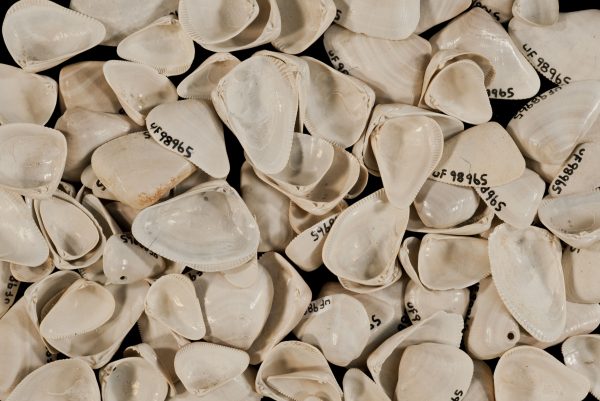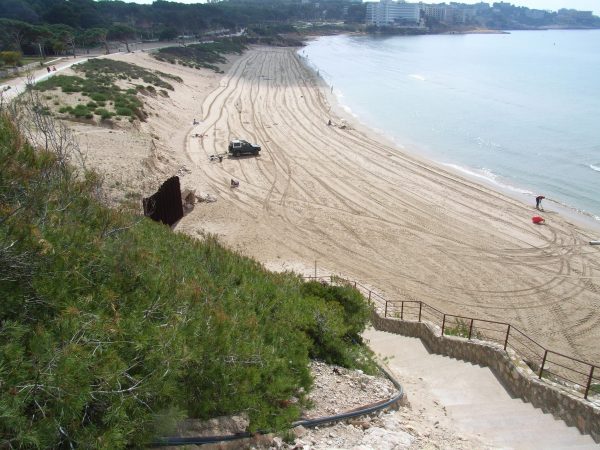
Florida Museum photo by Jeff Gage
Tourism may be damaging the very destinations treasured by visitors. Global tourism has increased fourfold over the last 30 years, resulting in human-induced shell loss that may harm natural habitats worldwide, according to Florida Museum of Natural History Thompson Chair of Invertebrate Paleontology Michal Kowalewski.
Appearing in the journal PLOS One on Jan. 8, 2014, the new study by researchers from the Florida Museum on the UF campus and the University of Barcelona demonstrates that increased tourism on the Mediterranean coast of Spain correlated with a 70 percent decrease in mollusk shells during the tourist season in July and August and a 60 percent decrease in other months. Kowalewski, lead author on the study, said scientists fear shell removal could cause significant damage to natural ecosystems and organisms that rely on shells.
“Tourism affects shells in many ways, including trampling, use of recreational vehicles, shell collecting and use of heavy machinery to clean and groom beaches,” Kowalewski said. “With an increase in mass tourism all those processes inevitably intensify. Our research is best described as a case study that attempts to quantify shell loss due to tourism-related activities. It’s too early to tell whether this depletion is substantial enough to trigger major environmental changes. However, our results suggest that we should not ignore this issue.”
In the study, researchers conducted multiple monthly surveys from 1978 to 1981 and from 2008 to 2010 on Llarga Beach, a small stretch of shoreline on the coast of Spain. Based on area hotel sales data, researchers estimate the number of tourists visiting the beach increased threefold over the last 30 years, with most visits during the summer. Over the same time period, the number of shells on the beach decreased by more than 60 percent. The survey area has experienced no new commercial fisheries or urban development since the 1970s, suggesting human activity unrelated to tourism is unlikely to have contributed substantially to the shell loss, Kowalewski said. Changes in ecosystem structure and local environmental conditions, which could potentially contribute to a natural decrease in shell numbers, were not observed, he said.
Although a popular destination, Llarge Beach is not a major tourist hot spot. However, shell removal was higher during the summer when more tourists visited the area and tractors were used to groom the beach, and shells were more abundant during the winter when fewer tourists visited the area. If a relationship between increased tourism and a decrease in shell abundance can be detected at a place where tourism grew at slower pace than observed globally, it is likely that beaches more heavily frequented by tourists have experienced more substantial impact, Kowalewski said.

Florida Museum photo by Jeff Gage
“Although significant research has been done on the impacts of human activity on live shellfish, including recreational harvesting and curio collecting, we are still lacking rigorous studies estimating the scale of dead shell removal by tourism-related activities,” Kowalewski said. “Shells are remarkable in that they serve multiple functions in natural ecosystems, from beach stabilization to building materials for bird nests.”
Shells also provide a home or attachment surface for diverse marine organisms, including algae, sea grass, sponges and other micro- and macro-organisms. Hermit crabs use shells as their protective armor, while fish use shells to hide from predators. These discarded exoskeletons of mollusks, including clams and oysters, are also important because most are made of calcium carbonate and in many coastal habitats they dissolve slowly and recycle back into the ocean.
“The study may prompt more systematic assessments of shell removal due to tourism,” said Geerat Vermeij, a mollusk shell expert and distinguished professor of geology with the University of California Davis who was not involved in the study.
“Molluscan shells are of prime importance to hermit crabs, and although sand beaches are not good places for such crabs, dead snail shells on mud-flats and rocky shores do form a primary resource for abundant hermit crabs,” Vermeij said. “More subtly, many small organisms settle on dead shells, and so removing such shells will eliminate habitats for these colonists.”
Karl Flessa, a mollusk expert and professor of geosciences at the University of Arizona, said he is both impressed and distressed at the study’s results.
“I’m impressed because the authors have done the right thing by studying the same place over time,” Flessa said. “There may be problems with differences in collecting methods and long-term environmental changes. But the case they make is still a very strong one—far better than they could have done by comparing a tourist-free beach with a tourist-infested one.”

Photo by Jordi Martinell
Though tourism-related shell loss may one day prove harmful, Kowalewski said more rigorous quantitative case studies are needed to fully understand the role of tourism-associated processes so reliable beach management practices aimed at shell protection can be developed.
Some countries already recognize the negative effects of shell removal, including the Bahamas, which limits the quantity of shells tourists can export without special permits. However, given the multitude of tourism-related processes that potentially contribute to shell loss, limiting shell collecting may not even be the right answer, according to Kowalewski.
“Humans may play a significant role in altering habitats through activities that many would perceive as mostly harmless, such as removing or destroying seashells via various tourism-related activities,” he said. “It is important that we continue to investigate the more subtle aspects of tourism and their impact on shoreline habitats.”
Study co-authors were Rosa Domènech and Jordi Martinell with the Institut de Recerca de la Biodiversitat and Departament d’Estratigrafia, Paleontologia i Geociències Marines, Facultat de Geologia, Universitat de Barcelona, in Barcelona, Spain.
The study may be viewed online at http://dx.plos.org/10.1371/journal.pone.0083615.
Learn more about the Invertebrate Paleontology at the Florida Museum.